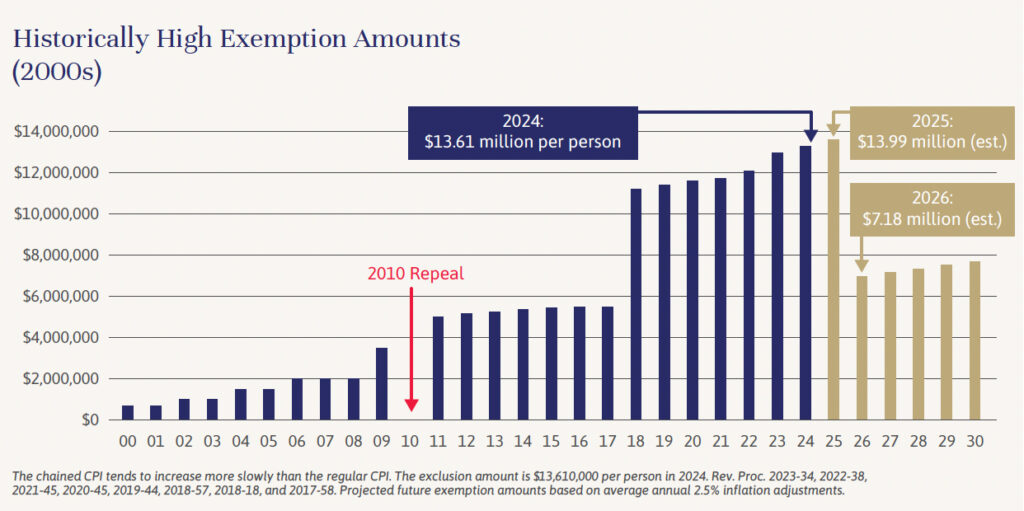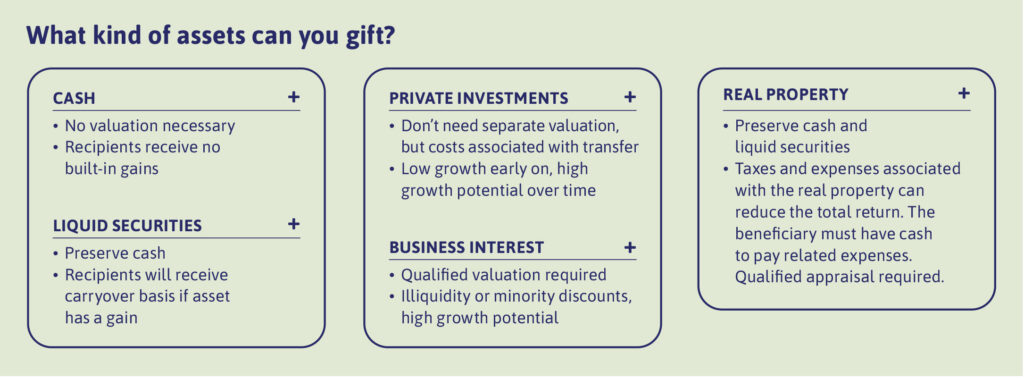
Independent Thinking®
Before Sunset: Time Is Running Out on the Estate Tax Exemption
September 30, 2024

Sunset is when the sun appears to sink below the horizon. However, when it comes to estate planning, sunset is when the current gift, estate and generation-skipping transfer, or GST, tax exemption under the Tax Cuts and Jobs Act of 2017 gets cut approximately in half. After 2025, individuals will be limited to giving an estimated $7.18 million tax-free to their heirs, down from the current $13.61 million “use-it-or-lose-it” exemption amount. A historic window of opportunity to maximize intergenerational wealth transfer is set to close soon.
Depending on elections in November 2024, it is possible that Congress – with the future president’s approval – could extend the historically high exemption amount by passing legislation similar to the Tax Cuts and Jobs Act of 2017. However, such an extension seems unlikely at this point, given the extent to which it would increase deficits. The Congressional Budget Office recently estimated that the cost of extending just the exemption levels through 2033 would be approximately $167 billion.
If 2026 still seems a way off, consider that some trust and estate attorneys are already turning away clients as the deadline looms. Anyone able to take advantage of the full exemption who fails to use more than $7.18 million will likely lose the remainder as of 2026, as illustrated in the chart below. Also lost after 2025 will be all the potential estate-tax-free appreciation of those assets, perhaps for generations to come. If that $13.61 million generated, say, a net 7% return over 30 years, that’s more than $40 million of savings at the current 40% gift and estate tax rate. For an ultra-high net worth couple able to gift twice that amount, the savings would be more than $80 million.
In short, this is the time to address three key questions: Can you afford to gift? If so, how much? And what should you give?
Preserving peace of mind is the starting point. Individuals and couples need to know that they will retain sufficient assets to sustain their lifestyle and meet other goals – a decision that should be made only after a thorough financial analysis. And even if parents or grandparents are ready to give, family members might not be ready to receive. Next-generation readiness and, often, complex family dynamics must be considered too. For those whose financial analysis shows that they should not gift more than the $7.18 million threshold ahead of the sunset, it is still prudent to begin estate planning sooner rather than later to maximize potential future growth outside of the estate and reduce the potential future estate tax exposure.
Trusts can play a key role here, helping to ease this transition and in planning for the unknown, including future generations. Spousal lifetime access trusts, or SLATs, Dynasty Trusts, and Intentionally Defective Grantor Trusts, or IDGTs, can preserve and protect wealth (see below for a brief guide to these three trust structures). Structuring any trust as a grantor trust amplifies the power of estate planning, as the grantor continues to pay the income taxes on the trust. This allows trust assets to compound over time unencumbered by taxes while the grantor reduces the amount of their estate that could be subject to future estate taxes without using up any additional exemption amount.

Keep in mind that the choice of an individual and/or corporate trustee is critical. Both an individual trustee and corporate trustee should know the family well and be confident that they can carry out their duties for a long time. Moreover, an individual and corporate trustee can be named together as co-trustees where the corporate trustee can educate and otherwise support the individual trustee by lessening the administrative burden, as well as assisting with future trust management and governance issues. (For more information, please visit https://evercorewealthandtrust.com/choosing-the-right-trustees/).
The next consideration is generally which assets to give and how to structure those gifts. Cash, real estate, public securities and private investments each have associated implications that need to be considered, as illustrated below. Each situation is different, so it’s important to run different test scenarios taking into account factors such as basis, capital appreciation and liquidity – to evaluate the pros and cons of gifting each type of asset.
Cash is straightforward, as there are no concerns around valuation or embedded gains. However, most people have a limited amount of cash on hand, and what they do have is reserved for lifestyle needs. The next option would be publicly traded securities, which, while also relatively easy to gift, require the consideration of additional planning issues, such as embedded capital gains. It’s important to know that assets gifted during lifetime will retain their tax basis and will not receive a step-up in tax basis at death. In other words, many assets – other than certain exceptions like retirement accounts – will have all the capital gains disappear if still owned at death, which does not apply to assets given away during life.
Private investments, such as private equity funds, can also be a great option for gifting; although gifting such assets can often involve greater complexity. These assets typically have significantly lower valuations early on but can later grow substantially for the benefit of heirs. (See the article by Sean Brady on planning strategies for private fund principals.) Similar to private equity investments, closely held business interests and real property can also be powerful estate planning tools, especially taking into account potential lack of marketability and lack of control discounts for gift purposes.
There is no one optimal strategy for gifting that works for everyone. It’s vital to customize any gifting plan and weigh the trade-offs in gifting different types of assets by working with a collaborative team of advisors, including your wealth manager, attorney, accountant, and potentially other specialists. Gifting these amounts is a big decision, one that should only be made in the context of a comprehensive estate plan. But if gifting is a goal, there may be limited time to do it in the most tax-efficient manner.

Justin Miller is a Partner at Evercore Wealth Management and Evercore Trust Company and the National Director of Wealth Planning. He can be contacted at [email protected]. Neza Gallitano is a Managing Director and Wealth & Fiduciary Advisor; and Alex Pavelock is a Director and Wealth & Fiduciary Advisor. They can be contacted at, respectively, [email protected] and [email protected].
To view Justin, Neza and Alex discussing this topic in a recent webinar or to learn more, please visit https://evercorewealthandtrust.com/independent-thinking-panel-gifting-before-the-estate-tax-exemption-sunset-the-whys-why-nots-and-when/ or contact your Evercore Wealth Management and Evercore Trust Company Advisor.
Trusts to Consider before the Sunset
Editor’s note: This guide is extracted from an article published in Independent Thinking in 2021; the amounts have been adjusted to reflect subsequent inflation.
DYNASTY TRUST
One of the most popular wealth transfer strategies is to create a Dynasty Trust in Delaware or in other states with strong asset protection laws, for children, grandchildren and future generations.
A Dynasty Trust could not only prevent future gift, estate and GST tax, but it could also help protect assets for family members from future creditors in the wake of any number of potential events, such as a car accident or divorce. For instance, a married couple could transfer $27.22 million tax-free into a Dynasty Trust. Those assets and all the future growth would be permanently set aside for family members without being subject to gift, estate or GST tax. Moreover, many asset protection trust states like Delaware have eliminated the common-law rule against perpetuities, which means the Dynasty Trust can support multiple generations of a family for hundreds of years.
Dynasty Trusts are often set up as grantor trusts, allowing the grantor to pay all the income tax for the trust without any gift tax consequences. In other words, the Dynasty Trust’s assets grow free of income tax, and the payment of income tax by the grantor further reduces the grantor’s taxable estate. On the other hand, wealthy families in high income-tax states may want to consider creating a non-grantor trust, where the trust pays its own tax, in a jurisdiction where the Dynasty Trust would not be subject to any state income tax. As a non-grantor trust in a state without a state income tax, the Dynasty Trust could continue to grow free of estate, gift and GST tax, as well as state income tax for generations – subject to potential state sourcing rules and throwback tax, for example, in California and New York.
SPOUSAL LIFETIME ACCESS TRUST
Not all wealthy parents are comfortable permanently setting aside millions of dollars for children and future generations, especially if they might need or want the assets back in the future. In that case, a spousal lifetime access trust, or SLAT, could be the optimal solution to maximize the gift, estate and GST tax savings while still protecting assets for the spouses for the rest of their lifetimes. With a SLAT, one spouse would create a $13.61 million irrevocable trust with their separate property to benefit the second spouse. After the second spouse dies, the SLAT protects future generations, free of gift, estate and GST tax. It is important to remember that SLATs are irrevocable trusts, which could be a big issue if spouses get divorced in the future.
It may also be possible for the second spouse to create a similar $13.61 million SLAT for the first spouse. However, the two SLATs would need to be independent and different enough to avoid what is known as the “reciprocal trust doctrine” and “step transaction doctrine.” Accordingly, the first spouse is taking a real risk that the second spouse might not necessarily fund a second SLAT for the first spouse. Suppose there is concern about the reciprocal trust or step transaction doctrine. In that case, instead of the second spouse creating a similar SLAT for the first spouse, another option could be for the second spouse to utilize their individual $13.61 million exemption by creating an entirely different type of trust, such as a Dynasty Trust, for future generations.
Typically, SLATs are grantor trusts, similar to Dynasty Trusts. As an alternative, careful drafting may make it possible to create a spousal lifetime access non-grantor trust, or SLANT. As a non-grantor trust, the SLANT would grow free of state income tax in a jurisdiction such as Delaware, subject to potential state sourcing rules and throwback tax, for example, in California and New York.
INTENTIONALLY DEFECTIVE GRANTOR TRUST
Families looking to maximize the amount they can leave to future generations free of gift, estate and GST tax can consider several strategies that maximize use of the current high exemption amounts. A sale to an intentionally defective grantor trust, or IDGT, which could be a Dynasty Trust or SLAT, is one of the most powerful strategies to set aside substantial amounts of assets for future generations. Typically, the first step is to fund the IDGT with an amount equal to 10% of the assets that the IDGT will be acquiring. The initial gift is often referred to as seeding the trust, although some practitioners are comfortable eliminating this step if there are adequate beneficiary guarantees.
For example, a married couple who are parents could gift $20 million to an IDGT without fully utilizing their entire combined exemption amount, and the IDGT could then buy $200 million worth of assets from the parents for a promissory note. The IRS publishes applicable federal rates monthly; the minimum interest-only payment that the parents would need to charge on a promissory note for 30 years would be 4.1% (for a loan made in October 2024). To make the sale to IDGT strategy even more effective, wealthy families often sell assets, such as closely held business interests, to the IDGT at a discount due to their lack of marketability and control. Families could create a family limited partnership, or FLP, or a family LLC to manage the family’s investments. It is essential that the entity has a legitimate business purpose and that the family respects both the form and substance of the structure. For instance, an FLP interest could have a $300 million undiscounted value but could be purchased by the IDGT for a $200 million promissory note if a valuation provided a 33.33% discount for lack of marketability and control. If such an asset had a 7% net growth rate over a 30-year period, approximately $1.5 billion could be transferred to future generations completely free of gift, estate and GST tax.
Every family has unique characteristics and dynamics, and again, any plan should reflect the collaborative counsel of advisors, including a Wealth & Fiduciary Advisor, attorney and accountant. A professional appraiser also should be included to value assets other than cash or publicly traded securities. And don’t forget to file Form 709, United States Gift (and Generation-Skipping Transfer) Tax Return, to report any gifts that take advantage of the exemption amount.
